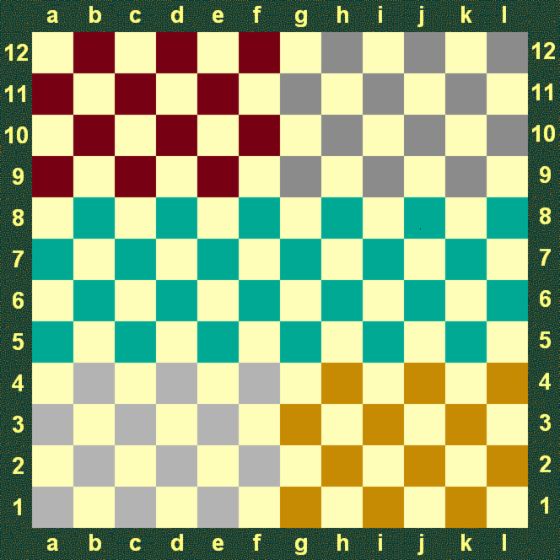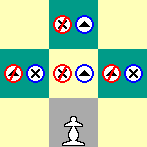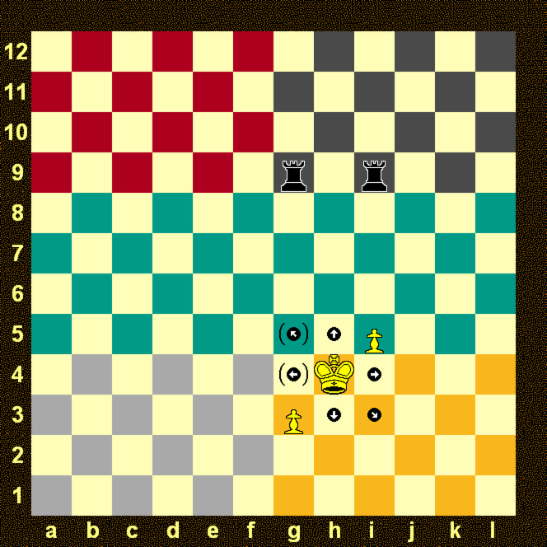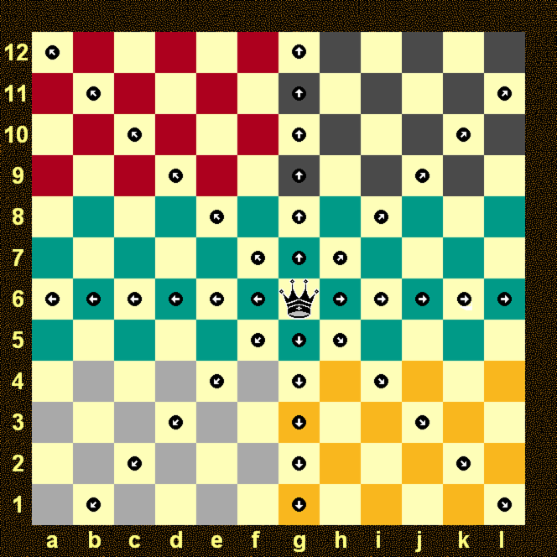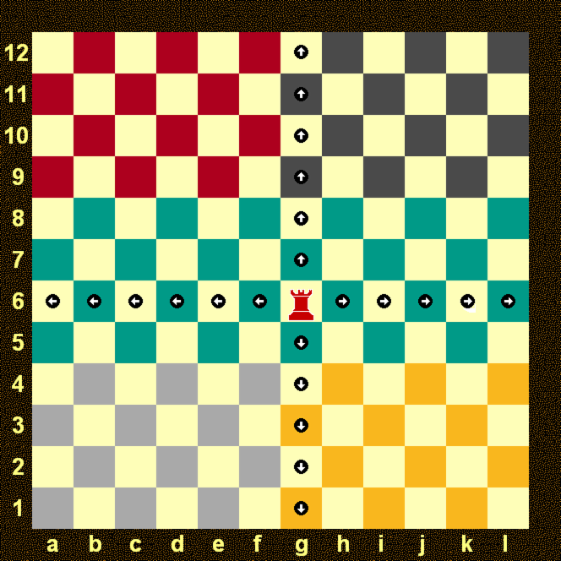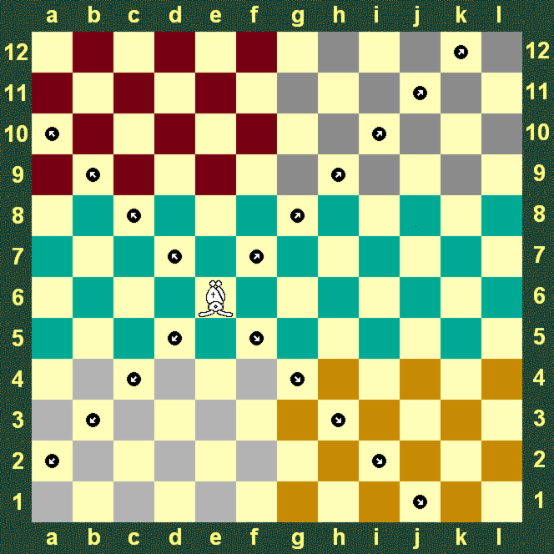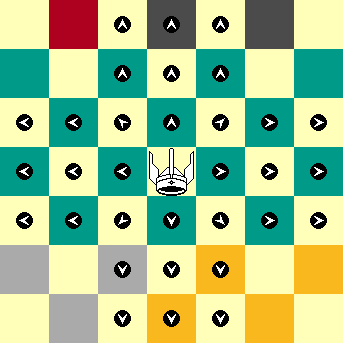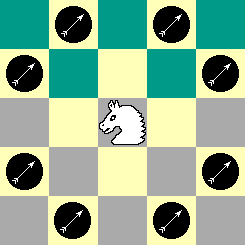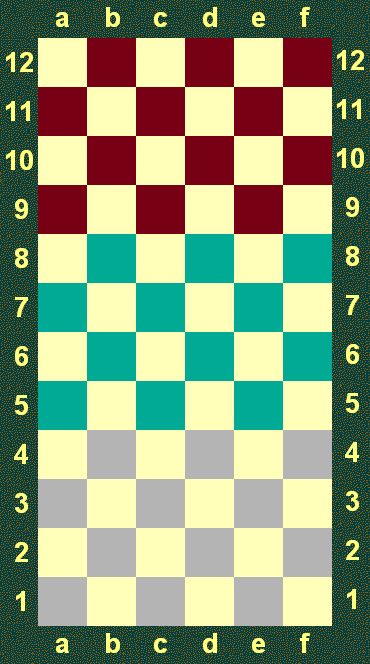Complete rules
It is hoped that players will find that these rules clearly and precisely regulate the overwhelming majority of situations arising during a game. However, players are
encouraged to seek further clarification by completing the feedback form available on the Home page.
In these rules the words 'he', 'him' and 'his' have been used interchangeably with 'she' and 'her'. Specific terms in Judtho are introduced in italics.
TABLE OF CONTENTS
Section 1: The nature, objectives and process of the game of Judtho
1.1 Overview and basic principles of the game
1.1.1 Type of game and number of players
1.1.2 Pieces and board
1.1.3 Names and initial relationships of the players
1.1.4 The aims of the game
1.1.5 The King and regicide
1.1.6 The stages of the game
1.1.7 The First Conquest
1.1.8 The Second Conquest
1.1.9 The Third Conquest and conclusions of the game
1.2 The processes of the game
1.2.1 Assembly definition
1.2.2 The Judtho pieces
1.2.3 The order of play
1.2.4 The Judtho Board
1.2.5 The Kingdoms of the Board
1.2.6 The rules of placement of the pieces
1.3 The Battles and Conquests in Judtho
1.3.1 The names of the Battles
1.3.2 The Battle for Ascendancy
1.3.3 The First Conquest
1.3.4 The Battle for Control
1.3.5 The Second Conquest
1.3.5.1 The Second Conquest: Victory for the Double Alliance
1.3.5.2 The Second Conquest: Defeat of the Double Alliance
1.3.5.3 The Second Conquest: Formation of a Second Double Alliance
1.3.6 The Battle for Dominion
1.3.7.1 The Conclusion: Victory for the Triple Alliance
1.3.7.2 The Conclusion: Defeat of the Triple Alliance
1.3.7.3 The Conclusion: Victory of one Double Alliance over the other
1.4 Premature cessations of play
1.4.1 Resignation
1.4.2 Departure
1.4.3 Agreement of a draw
Section 2: The moves of the pieces
2.1 The general move
2.2 The Pawn
2.3 The King
2.4 The Long Range pieces
2.4.1 The Queen
2.4.2 The Rook
2.4.3 The Bishop
2.5 The Short Range pieces
2.5.1 The Princess
2.5.2 The Prince
2.5.3 The Knight
Section 3: Judtho Duo
Section 4: Judtho Trio
___________________________________________________________________________
Section 1: The nature, objectives and process of the game of Judtho
1.1 Overview and basic principles of the game
1.1.1 Type of game and number of players
The game of Judtho is a game of strategy, based on chess, ideally played with four people (Judtho Quattro) although it can be played by two (Judtho Duo) or three
(Judtho Trio) people. Judtho Quattro (hereafter referred to as Judtho) is described initially.
1.1.2 Pieces and board
Players take turns to place and then move differently shaped and coloured pieces on and around a 12×12 square, multi-coloured chequered board called a Judtho board. The pieces
differ in the ways that they move and their abilities to remove other pieces. A piece is said to attack another piece if it could move to the attacked piece's square on its next move (thus
removing it). The players' sets of pieces are termed Armies. Each player initially controls an area of the board; these areas are termed Kingdoms.
1.1.3 Names and initial relationships of the players
The players are termed White, Yellow, Red & Black corresponding to the colour of their pieces and Kingdoms. Each player begins the game with one Rival and two
Opponents. For example, White's Rival is Yellow (the Light Rivals) and Red and Black are both Opponents of White & Yellow. Similarly, Red's Rival is Black (the Dark Rivals)
and White and Yellow are both Opponents of Red & Black. Rivals compete with each other to defeat one of their Opponents. Rivals cannot initially capture each other's pieces (wherever they are on
the board) nor place pieces in the other Rival's Kingdom. However, a piece may pass through a Rival's Kingdom, provided the piece completes the move outside the Kingdom.
1.1.4 The aims of the game
The aim in Judtho is to obtain the most points at the end of the game. Points are awarded for defeating Opponents' Armies - the victory over an Opponent's Army is termed a Conquest. A
complete game of Judtho Quattro will always have three Conquests with more points given to the later Conquests.
1.1.5 The stages of the game
As Judtho begins with the board empty, the first stage of the game is the Assembly of the pieces where players place, but cannot move, their pieces. The subsequent stages are called
Battles. Each Battle ends in the Defeat of one of the Armies and a change in the relationships of the players.
1.1.6 Conquests
If a player's King is captured or attacked by a Knight (Knatched), that player's Army has been Conquered by the Conquering player (who has achieved a Conquest). It is also
possible to achieve a Conquest by capturing all of an Opponent's pieces except for the King - this is termed Annihilation.
1.1.7 The First Conquest
With the First Conquest, an Unstable Alliance is formed between the Conquering and Conquered players. The Unstable Alliance is so termed because the objective of both players
within it is to conquer one of the two remaining single armies. All existing Rivalries are broken and so the two single players become Opponents of the Unstable Alliance whilst remaining
Opponents of each other.
1.1.8 The Second Conquest
With the Second Conquest, two Stable Alliances are formed. If one of the players of the Unstable Alliance is successful in conquering a single army, then that player forms a
Stable Alliance with the defeated single army and the second Stable Alliance is formed between the other player of the former Unstable Alliance and the undefeated single player.
However, if one of the single players defeats the other, then a Stablel Alliance is formed between those players and the Unstable Alliance becomes the second Stable Alliance.
1.1.9 The Third Conquest and conclusions of the game
The Third Conquest is simply the victory of one Stable Alliance over the other. In exceptional circumstances, the game may be adjudicated. Play may also be ended by players resigning, agreeing a draw
or declaring the game void.
1.2 The Assembly of the pieces
1.2.1 Assembly definition
The Assembly is the stage of the game where players take turns to place one piece on the board. No pieces can be moved once placed until the Assembly is complete.
1.2.2 The Judtho pieces
Each player places 15 pieces (A King and a Queen, either a Prince or a Princess, two each of Rooks, Knights and Bishops and six Pawns) within her Kingdom. Symbols for the White pieces are given
below. The letters in parentheses are used in the algebraic notation for recording the moves of the game.
-
The colours of the pieces are White and Yellow (the Light Pieces) and Black and Red (the Dark Pieces).
1.2.3 The order of play
Generally, throughout the whole game, play proceeds in the sequence: White, Red, Yellow and Black, returning again to White. The only exception to this is when a Triple Alliance is formed (see
Section 1.3.5.1).
1.2.4 The Judtho board
The Judtho board is a 12 × 12 square, multi-coloured chequered board. The 12 vertical columns of squares (labelled a to l) are called files. The 12 horizontal rows of squares (labelled 1 to
12) are called ranks. A straight line of squares (either light or dark), touching corner to corner, is called a diagonal.
1.2.5 The Kingdoms of the Board
The area in which a player may place her pieces is called her Kingdom. This is a rectangular area of 6×4 squares at each corner of the board. The colours of the dark squares are appropriate
for each player. The players' Kingdoms are defined as follows:
The White Kingdom is defined by the light and light grey squares between a1 and f4;
The Red Kingdom is defined by the light and red squares between a9 and f12;
The Yellow Kingdom is defined by the light and yellow squares between g1 and l4;
The Black Kingdom is defined by the light and dark grey squares between g9 and l12.
The area denoted by the light and turquoise squares between a5 and l8 (i.e. the 5th to 8th ranks inclusive) is termed Neutral Territory.
1.2.6 The rules of placement of the pieces
The pieces are placed according to the following rules:
1. The pieces can be placed in any order;
2. Either a player's Princess or Prince must be placed and thus 15 pieces are placed per player;
3. Players may not move any piece when placed and all pieces must be placed before White makes the first move.
1.3 The Battles of Judtho
1.3.1 The names of the Battles
The Battles in Judtho are named to reflect their increasing importance. They are listed below in the order that they take place:
The Battle for Ascendancy (from the Assembly to the First Conquest);
The Battle for Identity (from the First Conquest to the Second Conquest);
The Battle for Victory (from the Second Conquest to the Conclusion);
1.3.2 The Battle for Ascendancy
After the Assembly, players can move their pieces and do so in the same turn order as before. In this context, Ascendancy refers to the advantage a player gains by conquering another Army. Primarily,
players must avoid being conquered but they must also judge whether to try to win the initial Battle for Ascendancy or time their attack for later.
1.3.3 The First Conquest
The following changes take place immediately after the First Conquest and take effect before the next player moves:
1. The Conquering and Conquered Armies are joined in an Unstable Alliance. The player that has achieved the First Conquest is called the First Ally (as well as
the First Conqueror) and the other player is called the Second Ally. The pieces within the Unstable Alliance are friendly in status towards each other; i.e. they
cannot capture other pieces within the Unstable Alliance.
2. Either a Princess or a Prince (whichever was not chosen in the Assembly) is placed on an empty square by the First Ally within her Kingdom. In the very unlikely event of an empty
square being unavailable, the piece can be placed anywhere in Neutral Territory.
3. If the Second Ally's King was captured, then it is replaced on an empty square (of the Second Ally's choice) in the Second Ally's Kingdom. If the King was Knatched, it remains in
position.
4. The placement of pieces (as set out in 2 & 3 above) completes the Conquest move by the First Ally and takes effect before any other player moves. No other pieces may be moved or placed on the
board at this time.
5. Allies may only move pieces of their own colour on their own turn - e.g. the player who had the Red pieces can only move Red pieces even if he is now the First Ally of the Unstable
Alliance.
6. The move sequence is unchanged. For example, if Red and White are joined in an Unstable Alliance by Red conquering White, then Yellow will play next (immediately after Red's Conquest of White),
followed by Black, White, Red and Yellow again.
7. All existing Rivalries are immediately broken and so the remaining single players become Opponents of the Unstable Alliance whilst remaining Opponents of each other. So, following the
example given immediately above, White and Yellow can now capture each other's pieces and place pieces within each other's Kingdoms. The same applies to Red and Black. If, for
example, Red and Yellow are joined in an Unstable Alliance, Black remains an Opponent of Yellow and White (as well as now being an Opponent of Red).
Similarly, White remains an Opponent of Red and Black (as well as now being an Opponent of Yellow).
8. The First Ally receives 4 points for the First Conquest.
1.3.4 The Battle for Identity
This Battle, which ends in the Second Conquest, decides the identity of the two Alliances which will contest the final stage of the game.
1.3.5 The Second Conquest
The following changes take place immediately after the Second Conquest and take effect before the next player moves:
1. The player who achieves the Second Conquest (called the Second Conqueror) forms
a Stable Alliance with the conquered player. The second Stable Alliance is formed from the remaining two
players. The pieces within each Stable Alliance are friendly in status towards each other; i.e. they cannot capture other pieces within their Stable Alliance.
2. If the Second Conqueror did not achieve the First Conquest, then he places either a Princess or a Prince (whichever was not chosen in the Assembly) on an empty square within his Kingdom. In the very unlikely event of an empty square being unavailable, the piece can be placed anywhere in Neutral Territory.
3. If the Second Conqueror was also the First Conqueror, and she does not have both her Prince and her Princess on the board,
then she places whichever she does not have (if she has one on the board) or chooses which one to place (if she has neither on the board), on an empty square within her Kingdom. If she has
both Prince and Princess on the board, then she chooses a previously captured piece of her army (either the Queen, a Knight or a Rook) and places this on an empty square within his Kingdom. In
the unlikely event of none of these pieces being available, she can, instead of making a move, and following one or more of them being captured, place one of these pieces on an empty
square within her Kingdom.
3. If the Second Ally's King was captured, then it is replaced on an empty square (of the Second Ally's choice) in the Second Ally's Kingdom. If the King was
Knatched, it remains in position.
4. The placement of pieces (as set out in 2 & 3 above) completes the Conquest move by the First Ally and takes effect before any other player moves. No other
pieces may be moved or placed on the board at this time.
5. Allies may only move pieces of their own colour on their own turn - e.g. the player who had the Red pieces can only move Red pieces even if he is now the
First Ally of the Unstable Alliance.
6. The move sequence is unchanged. For example, if Red and White are joined in an Unstable Alliance by Red conquering White, then Yellow will play next (immediately
after Red's Conquest of White), followed by Black, White, Red and Yellow again.
7. All existing Rivalries are immediately broken and so the remaining
single players become Opponents of the Unstable Alliance whilst remaining Opponents of each other. So, following the example given immediately above, White and Yellow can now capture each other's
pieces and place pieces within each other's Kingdoms. The same applies to Red and Black. If, for
example, Red and Yellow are joined in an Unstable Alliance, Black remains an Opponent of Yellow and White (as well as now being an Opponent of Red). Similarly, White remains an Opponent of Red and Black (as well as now being an Opponent of Yellow).
The Second Conquest either results in victory or defeat of the Double Alliance or the formation of a second Double Alliance.
1.3.5.1 The Second Conquest: Victory for the Double Alliance
Conquest of either of the single Armies by the Double Alliance results in the formation of a Triple Alliance with the newly conquered Army becoming the Third Ally (the First and Second Allies of the
Double Alliance retain their ranks). Similar rules govern the Triple Alliance as those of the Double Alliance:
1. The Third Ally places either a Prince or Princess according to the rules as described above in the First Conquest section.
2. The Three Allies cannot capture each other's pieces. They must cooperate to achieve a Conquest of the remaining Army whilst avoiding any of their three Armies being conquered.
3. 4 points each are awarded to the First and Second Allies for achieving the Second Conquest.
4. Importantly, the move order changes in order to give the Single Player a good chance of victory. The Single Player alternates playing a move with each of the three
players of the Triple Alliance. The move order White, Red, Yellow, Black is preserved for the Triple Alliance, but is interspersed with the Single Player's moves.
5. An illustration of Rule 4 immediately above is given for clarity. Let's say White and Red are joined in a Double Alliance. White then captures the Black King. Black places a Black
Prince or Princess within the Black Kingdom, replaces the Black King on a vacant square within the Black Kingdom and becomes the Third Ally of the Triple Alliance. White and Red are awarded four
points each for the Second Conquest.
Red then moves next (as Red moves after White in the order White, Red, Yellow, Black) followed by Yellow. Thus, the move order after the Second Conquest is: Red, Yellow, Black, Yellow, White,
Yellow, Red, Yellow, Black, Yellow, White, Yellow and so on.
1.3.5.2 The Second Conquest: Defeat of the Double Alliance
If either Army of the Double Alliance is conquered by one of the single players, the conquering player will become the First Ally of a Triple Alliance with the former First and Second Allies of the
Double Alliance becoming the Second and Third Allies respectively. Similar rules (as described above) govern this Triple Alliance except for the following:
1. The (new) First Ally (i.e. the player who has achieved the Second Conquest) places either a Prince or Princess within his Kingdom according to the rules as described above in the First Conquest
section.
2. The First Ally receives 8 points for achieving the Second Conquest.
1.3.5.3 The Second Conquest: Formation of a Second Double Alliance
If one of the single players conquers the other, a second Double Alliance is formed with the conquering player becoming the First Ally. Corresponding rules pertaining to the Double Alliance as
described above (after the First Conquest) apply for this Double Alliance also.
The move sequence is unchanged. For example, if White and Red were joined in a Double Alliance and Yellow has conquered Black to form a second Double Alliance, then Black will play next followed by
White, Red, Yellow and Black again.
1.3.6 The Battle for Dominion
In this final Battle, two opposing forces fight to achieve the final Conquest that will win the game. Often the forces will be unequal; i.e. in the case of a Triple Alliance facing a single player.
Although the Triple Alliance will have great material superiority, it can be defeated by the Conquest of any one of its three Armies. Alternatively, two Double Alliances may face each other, each
knowing that the next Conquest will be the last.
1.3.7.1 The Third Conquest: Victory for the Triple Alliance
Conquest of the single player's Army by the Triple Alliance immediately results in a win for the Triple Alliance and the end of the game. 8 points are awarded to each of the Three Allies.
1.3.7.2 The Third Conquest: Defeat of the Triple Alliance
Conquest of any one of the Triple Alliance's Armies immediately results in a win for the single player and the end of the game. 24 points are awarded to the single player.
1.3.7.3 The Third Conquest: Victory of one Double Alliance over the other
Conquest of one of the Double Alliance's Armies immediately results in a win for the other Double Alliance and the end of the game. 12 points are awarded to each of the two Allies of the victorious
Second Alliance.
1.4 Premature cessations of play
The Departure of one or more players or a draw by agreement are the only possibilities for a premature cessation of play in Judtho (i.e. cessation before the Third Conquest). In either case,
players' Material Scores may be used to determine the final positions in the game.
1.4.1 Material Score
A player's material score is the sum of her pieces' values (according to the tables below) of her Army (i.e. of her colour only) remaining on the board plus the sum of the
values of all Opponents' pieces that she has captured.
In Judtho Quattro and Judtho Trio, the following piece values are assigned:
- Pawn 1
- Bishop 4
- Rook 6
- Knight 6
- Queen 10
- Prince and Princess 12 each
- Pawn 1
- Bishop 3
- Rook 5
- Knight 6
- Queen 9
- Prince and Princess 12 each
1.4.2 Departure
1. Departure is defined as the voluntary cessation of play by a player. Departure is strongly discouraged and incurs a significant points penalty. However, a player may depart at any time,
for any reason and has no obligation to disclose those reasons.
2. If one player leaves (Departs) at any time in the game and there has been no Conquest, 8 points are given to each of the remaining players, unless all three players agree the game should be
continued at a later time or declared void.
3. If one player has achieved a Conquest, 4 points are given to that player as usual. Then, to the remaining players, 6 points are given.
4. If there have been two Conquests, points are given as usual. Then, to the remaining players, 4 points are given.
1.4.3 Agreement of a draw
A draw may be agreed at any time but there must be unanimous agreement among players. If any player disagrees, play must continue or the game declared void.
Section 2: The moves of the pieces
2.1 The general move
Following the Assembly, a move in Judtho consists of moving a piece from one square to another according to the rules governing the movement of that piece. If the destination square is occupied,
then the occupying piece is removed from the board (captured). Note that only Opponents' pieces can be captured; it is not legal to capture one's own pieces or pieces belonging to a Rival or an
Ally.
2.2 The Pawn
The Pawn moves one or two squares forwards (i.e. towards the Opponents' back rank) but captures one square diagonally. It can also jump over another Pawn provided the destination square is
unoccupied. It cannot jump over any other piece. If the Pawn reaches the Opponents' back rank, then it is promoted to any piece except for a King. (Note there is no en passant rule in
Judtho.)
The King moves one square in any direction. Players must avoid it being captured or attacked by a Knight (knatched) - see 1.16 above. However, it is legal for the King to move to a square where it could be captured and, indeed, this must happen if there are no other legal moves (i.e. there is no stalemate rule in Judtho).
The Long Range pieces comprise the Queen, the Rook and the Bishop. All of these pieces move in straight lines and can move from one edge of the board to another. None of these pieces can jump and none can make multiple captures.
2.4.1 The Queen
The Queen moves in any direction and any number of squares.
The Rook moves along a rank or file any number of squares.
The Bishop moves diagonally any number of squares.
The Short Range pieces comprise the Princess, Prince and the Knight. All Short Range pieces can make multiple captures and have limited range. In addition, the Princess and the Knight can jump (in fact, the Knight only jumps when it moves). Also, the Prince and the Knight have more complex move patterns (i.e. not simple linear movement).
The Prince's move diagrams use the following type of symbols:
The Princess' move diagrams use the following type of symbols:
The Knight's move diagram uses the following symbol:
2.5.1 The Princess
The Princess moves up to four squares in any direction. She can jump to any square within that range in one direction, either to an empty square or capturing the opponents' piece occupying her destination square. She can also make multiple captures (up to four pieces in one move). Note that jumping and multiple captures cannot be combined.
The Prince moves up to three squares along a rank or file or up to three squares parallel to these squares, moving away from the original square. The Prince cannot jump but can make multiple captures (up to three pieces in one move).
The Knight jumps in an L-shape:
The Knight has 3 special powers:
1. It jumps over pieces so it is never blocked by its own pieces.
2. Instead of moving, it can capture any piece that it attacks (distant and, potentially, multiple, distant captures). The Knight can potentially capture up to eight pieces in
one move.
3. If a Knight attacks (termed "knatches") an opponent's King, that King is dethroned and a Conquest is achieved.
Section 3: Judtho Duo
Judtho Duo follows the same rules of Judtho Quattro with the following exceptions:
1. The game is played on half the board as shown below:
Section 4: Judtho Trio
Judtho Trio follows the same rules of Judtho Quattro with the following exceptions:
1. One player controls two Armies (e.g. White & Yellow), whereas the other two Armies (e.g. Red & Black) are controlled by one player each. These are called the SIngle Player and the Partnership respectively.
2. The Partnership may consult in the following way only: the player who does not have the move may write one suggested move only per turn and pass it to the player who has the move.
3. The game is won when either the Single Player or the Partnership achieves Regicide or Annihilation. A draw could be agreed if both sides have exactly the same amount of material.










